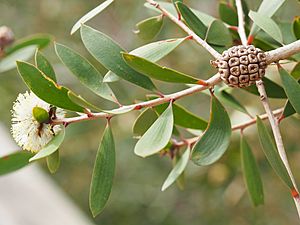Melaleuca globifera facts for kids
Quick facts for kids Melaleuca globifera |
|
|---|---|
 |
|
| M. globifera leaves, flowers and fruit | |
| Scientific classification | |
| Genus: |
Melaleuca
|
| Species: |
globifera
|
Melaleuca globifera is a type of shrub or small tree that belongs to the myrtle family, called Myrtaceae. It grows only in the southwest part of Western Australia, which means it is endemic there. This plant is known for its bushy shape, papery bark, and round clusters of flowers that grow at the ends of its branches.
Contents
What Does Melaleuca globifera Look Like?
Melaleuca globifera can grow up to about 10 metres (33 feet) tall. It has light brown bark that feels like paper. Its leaves are arranged one after another along the stem. They are usually 26 to 66 millimetres (1 to 2.6 inches) long and 7 to 20.5 millimetres (0.3 to 0.8 inches) wide. The leaves are flat, thick, and often have a slightly pointed end. You can also see 5 to 7 veins running side-by-side on each leaf.
Flowers and Fruit
The flowers of Melaleuca globifera grow in round clusters at the very ends of the branches. Sometimes, new growth continues from these branches even after the flowers have bloomed. Each flower cluster is about 30 to 35 millimetres (1.2 to 1.4 inches) across. It contains 12 to 20 smaller groups of three flowers.
The petals of these flowers are small, only about 1.7 to 2.5 millimetres (0.07 to 0.1 inches) long. They fall off as the flower gets older. The plant's stamens, which are the parts that produce pollen, are white to creamy yellow. They are grouped into 5 bundles around the flower, with each bundle holding 7 to 10 stamens.
Melaleuca globifera flowers from June to September. After the flowers, the plant produces fruit. These fruits are woody capsules that also grow in round clusters. Each fruit cluster is about 20 millimetres (0.8 inches) across.
How Melaleuca globifera Got Its Name
This plant was first officially described in 1812 by a botanist named Robert Brown. He wrote about it in a book called Hortus Kewensis.
The second part of the plant's scientific name, globifera, comes from two Latin words. Globus means "sphere" or "globe," and -fer means "carrying." So, globifera means "carrying spheres." This name refers to the round, globe-shaped fruit clusters that this plant produces.
Where Melaleuca globifera Grows
Melaleuca globifera is found along the coast near a town called Esperance in Western Australia. This includes areas like the Cape Le Grand and Cape Arid. It also grows on the nearby islands of the Recherche Archipelago. These areas are part of a larger natural region called the Esperance Plains biogeographic region.
This plant likes to grow in white or grey sand. You can also find it growing on rocky areas made of granite, and sometimes near salt lakes.
Conservation Status
The Government of Western Australia Department of Parks and Wildlife has listed Melaleuca globifera as "not threatened." This means that currently, there are enough of these plants in the wild, and they are not at risk of disappearing.
Images for kids
-
M. globifera at Lucky Bay in the Cape Le Grand National Park



